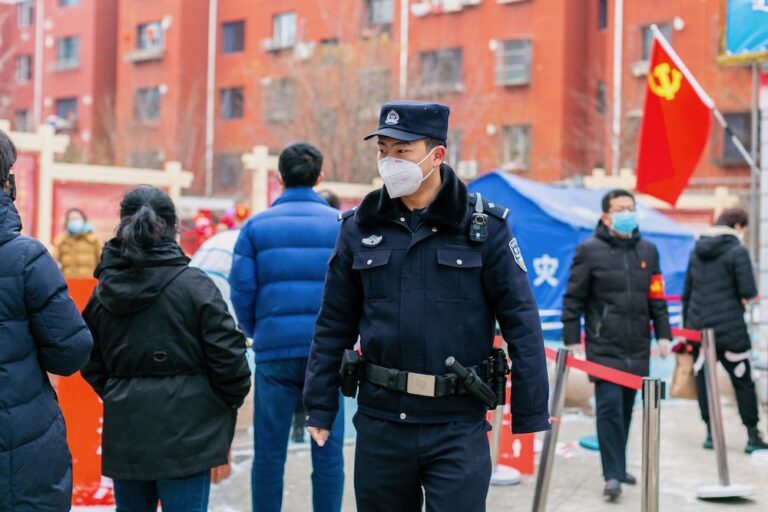Ai Weiwei's work is indelibly tied to the fight for free speech. He has consistently drawn attention to corruption and injustice in the Chinese government, most frequently with larger than life works that deliberately confront the viewer with their message.
Ai Weiwei.
Does the name sound familiar?
If it doesn’t, it should. There’s a pretty good chance you’ve come across the Chinese artist and his work before.
Remember the iconic Bird’s Nest Stadium from the Beijing Olympics in 2008? Ai Weiwei was the artistic consultant who designed it, before later speaking out against the Olympics. He has given the finger to Tiananmen Square and the White House, filled the Tate Modern’s Turbine Hall with 100 million hand-made porcelain sunflower seeds, shattered a 2000-year-old Han Dynasty urn, and is the subject of the award-winning documentary Ai Weiwei: Never Sorry.
In short? Ai Weiwei is a big deal.
Ai Weiwei’s work is indelibly tied to the fight for free speech. He has consistently drawn attention to corruption and injustice in the Chinese government, most frequently with larger than life works that deliberately confront the viewer with their message.
One such work currently on display at the Art Gallery of Ontario, in Toronto, Canada, is Straight. The piece consists of 38 tons of steel rebar that the artist and his team painstakingly collected from the site of the 2008 Sichuan earthquake. This earthquake claimed the lives of nearly 5200 schoolchildren who were crushed when their government-constructed “tofu-skin schools” collapsed. The rebar, which had been used to reinforce the concrete walls of the schools, serves as a forceful testament to the government’s responsibility for the tragedy when displayed on the gallery floor.
Ai Weiwei undertook an investigation of the Chinese government’s attempted cover-up of the incident, with violent consequences. He was severely beaten by Sichuan police to prevent him from testifying at the trial of fellow researcher Tan Zuoren, resulting in a brain hemorrhage. Since this incident Ai Weiwei has been under constant government surveillance and been subjected to numerous attempts to censor him, spending 81 days in illegal detention in 2011. Despite these obstacles, he has persevered, continuing to express himself through his art, writing, and social media accounts.
Ai Weiwei continues to live by the mantra, “If there is no free speech, every single life has lived in vain” (Ai Weiwei: Never Sorry).
On October 2, 2013, CJFE will join forces with the Art Gallery of Ontario (AGO) to present Ai Weiwei: Voices of Freedom. The evening will feature art, performance, and contemplation of the work of Ai Weiwei and the issues facing freedom of expression in China.
“My definition of art has always been the same. It is about freedom of expression [ . . . ] I don’t think anybody can separate art from politics. The intention to separate [the two] is itself a very political intention.” – Ai Weiwei
In light of our upcoming event and the current AGO exhibit Ai Weiwei: According to What, we have put together a collection of fascinating facts about the artist and activist.
10 things you may not know about Ai Weiwei (but should):
1. Ai Weiwei’s wife, Lu Qing, is also an artist. While her husband’s work is a form of activism, hers is a form of reflection. Lu produces a single work annually, filling a bolt of silk 82 feet long with painted patterns.
2. Ai Weiwei is an ambassador for Reporters Without Borders (RSF). His photographs will feature in RSF’s 2013 album “100 Photos for Press Freedom.” The latest issue was released on September 12, 2013, and was dedicated to the fight for free expression in China. Ai Weiwei’s work in this album chronicles his shadowing and surveillance by China’s secret police.
3. Ai Weiwei is a heavy metal musician. His most recent album was titled “The Divine Comedy” and he has released two singles on his YouTube Channel. The video for the first single, “Dumbass” is a dramatization of the artist’s arbitrary 81-day detention in 2011. His second, “Laoma Tihua” is filmed in the style of a hidden camera and documents several instances of dubious police behaviour.
4. Ai Weiwei is incredibly active on social media. You can find him on Twitter at @aiww. As the majority of his posts are delivered in his native Mandarin, a group of industrious artists have created a Twitter account that translates Ai Weiwei’s tweets into English (@aiwwenglish), which are then posted on a Tumblr account. You can also find him on Instagram at @aiww, for selfies, adorable pictures of the artist’s son, existential landscapes and more.
5. Ai Weiwei’s name is a banned search term on Sina Weibo, China’s answer to Twitter.
6. Ai Weiwei has very little involvement in the actual production of his works. He prefers to come up with the idea, make the main decisions, and have workers actualize his concepts. For this reason, his workers have referred to themselves as “hired assassins.”
7. Ai Weiwei lived in New York City for 12 years, where he studied at Parsons School of Design and the Art Students League of New York. During this time, he also developed an interest in blackjack, making frequent trips to Atlantic City. Today, he is still regarded as a top tier professional blackjack player amongst gamblers.
8. Ai Weiwei is a prolific documentary filmmaker. His most famous film is an investigation into the 2008 Sichuan earthquakes, titled Hua Lian Ba Er [Little Red Cheeks]. Another, Lao Ma Ti Hua [Disturbing the Peace] actually contains footage of his assault by Chinese police.
9. Ai Weiwei had never used a computer before 2005. But from 2006-2009, he maintained a blog in which he heavily criticized the Chinese government. Although the blog has been taken down by Chinese authorities, its contents have been collected in a book, “Ai Weiwei’s Blog: Writings, Interviews, and Digital Rants, 2006-2009.”
10. Ai Weiwei has addressed the erosion of China’s relationship with its own history in several works. As part of his conceptual piece Fairytale, the artist built a structure from 1001 Ming and Qing Dynasty doors that he collected following the demolition of these historic homes to make way for urban development. Another piece, Circle of Animals/Zodiac Heads (currently on display in Toronto’s Nathan Phillips Square), explores China’s relationship to its national consciousness and cultural objects.
Still want to know more? Keep an eye on CJFE’s Twitter account (@canadaCJFE) as we post a quote, fact or article about Ai Weiwei each day counting down to October 2.
This article was written by Alexandra Zakreski.



